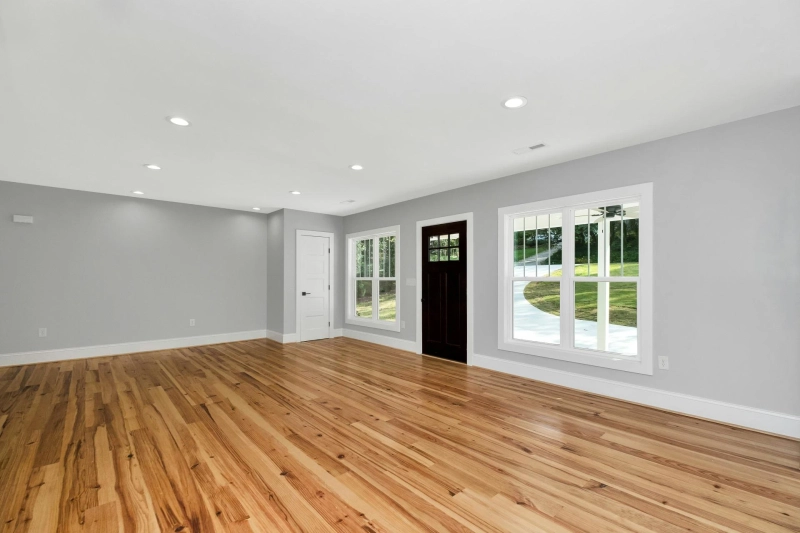You love your hardwood floors. Honestly, who doesn’t? They’re classic, durable, and give any home that warm, polished look you just can’t get with tile or carpet. But here’s the million-dollar question: How often should you refinish them?
If you’ve been noticing dull spots, scratches, or areas where the finish seems to have just vanished—don’t panic. Those signs don’t always mean you need a full sanding tomorrow. The right timing for refinishing hardwood floors depends on several things: traffic, finish type, how well you’ve cared for them, and of course, the wood itself.
Let’s break it down, floor-lover to floor-lover.
The General Rule: Every 7–10 Years (But Not Always)
On average, most hardwood floors need to be refinished every 7 to 10 years. That’s kind of the gold standard. But that number can shift based on how you live. Got pets? Kids? High heels and hallway traffic that could rival a shopping mall? Then you might be looking at more frequent hardwood floor refinishing.
On the flip side, if your home is low-traffic and you’ve been diligent about floor care—no shoes, regular cleaning, the whole deal—you could stretch it closer to the ten-year mark or even longer.
Sign #1: Your Floors Look Dull No Matter How Much You Clean
If your floor used to gleam and now it looks more… meh? That’s a red flag. A worn-out finish loses its shine, and no amount of mopping is going to bring it back. You might not need a full sanding just yet, but a buff and recoat (a lighter version of refinishing) could buy you a few more years before a full job is needed.
This is one of the first signs people notice when they start considering refinishing hardwood floors.
Sign #2: Scratches Are Everywhere—and Not Just on the Surface
A few scratches? Totally normal. Especially in high-traffic spots like entryways and living rooms. But if you’re seeing deep gouges or scratches that go through the finish and into the raw wood, that’s when it’s time for a proper hardwood floor refinishing.
Why? Because exposed wood is vulnerable to water damage, staining, and further wear. It’s like walking around without sunscreen—damage adds up fast.
Sign #3: Water Is Soaking In Instead of Beading Up
Water test time. Seriously, go grab a few drops and sprinkle them in an inconspicuous spot. If they bead up, your finish is still doing its job. If they soak in quickly, your protective barrier is gone—and that means the wood is absorbing moisture it definitely shouldn’t be.
This test is quick and free, and it tells you a lot about when to schedule your next hardwood floor refinishing project.
Sign #4: You’ve Got Discoloration or Sun Bleaching
Over time, even the best finishes can fade—especially in rooms with lots of sunlight. If your floors are starting to look patchy, uneven, or like they’re two different colors depending on where the sun hits, refinishing can bring everything back to a smooth, even tone.
This is especially common in older homes where refinishing hardwood floors hasn’t happened in a decade (or two... no judgment).
The Type of Finish Matters (More Than You’d Think)
Different finishes have different lifespans. Here's a quick cheat sheet:
- Oil-based polyurethane: Durable, amber tone, lasts around 7–10 years
- Water-based polyurethane: Clearer look, slightly shorter lifespan (5–8 years)
- Hardwax oils: Natural, low-VOC, but may need more frequent touch-ups (every 3–5 years)
- Aluminum oxide (factory finish): Super tough, found on prefinished wood, can last up to 25 years—but it’s harder to refinish later
Knowing your floor’s finish helps set realistic expectations about how often hardwood floor refinishing is necessary.
How Much Traffic Does Your Floor Really See?
Think about your daily life:
- Do you have pets running through the house like they’re training for a race?
- Do kids drop toys, drag chairs, or occasionally spill mystery liquids you don’t discover for days?
- Do guests (or you) wear shoes indoors?
If you answered yes to any of that, you’re probably looking at refinishing hardwood floors every 5–7 years. High traffic = faster wear.
Meanwhile, if you’re running a no-shoes, no-kids, no-pets kind of household? Hats off to you. You could stretch it to 10 years or even more.
When a Buff and Recoat Might Be Enough
Before you go all in on a full sanding job, ask if a buff and recoat could do the trick. This process lightly scuffs the existing finish and adds a new protective layer—no need to sand down to bare wood.
It’s quicker, cheaper, and keeps your hardwood floor refinishing schedule on a longer cycle. But it only works if the existing finish is still intact. Once the wood is exposed, sanding is the only option.
Bonus Tip: Keep a Maintenance Journal
Okay, this might sound a little Type-A, but keeping track of when you last had your floors done (and what kind of finish was used) will save you from guessing games later.
You’ll know what to look for, when to test, and when to budget for your next hardwood floor refinishing job. And trust me—future you will appreciate it.
Final Thoughts: Timing Is Everything (So Is Paying Attention)
There’s no exact date circled on a calendar for refinishing hardwood floors. Instead, it’s about noticing changes in your floor’s appearance and function. Are they dull? Scratched? Soaking in water? Showing wear faster than you expected?
Don’t wait until the wood is damaged or stained beyond repair. A well-timed refinish not only protects your floors but keeps them looking gorgeous for years to come.
Your floors are a major part of your home—and a little attention now can save you from major headaches (and costs) down the line.
Visit to find out more How Do You Get Scratches Out of Hardwood Floors? | Robar Flooring


